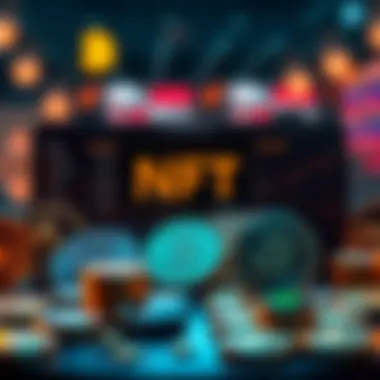Monetizing NFTs: Your Complete Guide to Profits


Intro
In recent years, the digital landscape has undergone a revolutionary transformation, particularly in how we think about ownership and value through technology. Non-fungible tokens, or NFTs, have emerged as a game-changing method for contributors and investors alike to harness this innovation. This guide intends to unravel countless possibilities tied to monetizing NFTs, discussing everything from the creation process to prevalent market dynamics. The convergence of art, creativity, and technology presents an exciting opportunity, albeit with challenges that require careful consideration.
Non-fungible tokens are far more than mere digital collectibles; they represent the ownership of a unique asset on the blockchain. Traditional assets typically hold value based on their inherent characteristics or scarcity, whereas NFTs tie value to perception, provenance, and connection with the community. This guide will serve not just as an entry point for newcomers but as an insightful reservoir for seasoned aficionados, helping you navigate this multifaceted environment.
Trends in Cryptocurrency
Current Market Trends
The world of cryptocurrency is not static; it oscillates with the ebb and flow of societal and technological trends. As we step into the latter half of this decade, several trends are standing out in the NFT space that can offer valuable insights for potential investors and creators:
- Increased Institutional Interest: Major financial institutions are not only exploring blockchain but actively investing in NFTs, signaling a shift in mainstream acceptance. Companies like Visa have started to think beyond just cryptocurrency transactions, indicating a positive outlook for NFTs.
- Diversity in Use Cases: Beyond art and collectibles, NFTs are increasingly entering areas such as gaming, music, and virtual real estate. The ability to tokenize virtually anything means endless possibilities.
- Eco-conscious Initiatives: Amid the growing concerns about the environmental impact of blockchain technologies, many projects are pivoting towards eco-friendly solutions. Notable blockchains like Tezos and Flow are gaining traction as low-energy alternatives for NFT creation and trading.
Emerging Technologies in Blockchain
What’s driving the NFT revolution is not just interest but also technological advancements. Key developments within the blockchain sphere are crucial to understand:
- Layer 2 Solutions: Innovations like the Lightning Network or polygon technology are aiming to increase transaction speeds and reduce costs, making NFT trading more accessible.
- Interoperability: The potential for NFTs to exist across multiple platforms enhances their utility. Projects working towards interoperability are making it possible for users to move their assets more freely across different ecosystems.
- Smart Contracts Evolution: As smart contracts become more sophisticated, NFT ecosystems can become more reliable for creators and investors. They can provide better governance over royalties and resale rights, which are essential for sustaining the creator economy.
Investment Strategies
Long-term vs. Short-term Investing
Deciding between long-term commitment or short-term gains in the NFT market can be a tricky balance. Each approach has pros and cons, and understanding these can enhance one's investment strategies:
- Long-Term Hold: Investors who opt for long-term holding can benefit from the potential appreciation of valuable assets over time. Historical data seems to indicate that exclusive and unique NFTs might multiply in value as the market matures.
- Short-Term Trading: On the flip side, short-term strategies allow investors to capitalize on immediate trends and fads. This can lead to quick profits but also increases the risk, as the market can shift swiftly.
Each strategy requires its due diligence, along with keen insights into market sentiment, making it critical to stay updated with trends and shifting dynamics.
Risk Management Techniques
Like any form of investment, entering the NFT market comes with its share of risks. Effective risk management can play a pivotal role in how one navigates this landscape. Here are a few techniques:
- Diversification: Just like with traditional investments, don’t put all your eggs in one basket. Spread your investments across multiple NFTs and categories to minimize potential losses.
- Research and Strategy: Deep research into market trends and specific projects should underpin any investment decision. Having a solid strategy can help reduce impulsive choices that might lead to losses.
- Set Limits: Establishing stop-loss orders or predetermined exit strategies can save you from hefty losses if the market takes a downturn.
Deciding to venture into NFTs is not merely about opportunities. Understanding both the risks and possibilities can position you better in a fluid and often volatile market.
As we move further into the intricacies of monetizing NFTs, it becomes clear that success hinges on both the technical framework and the ever-shifting market dynamics. With the foundational understanding of trends and investment strategies laid out, we are now positioned to delve deeper into actionable steps for creators and investors.
Understanding NFTs
In the rapidly evolving world of digital assets, understanding Non-Fungible Tokens (NFTs) has become essential for anyone looking to engage with this burgeoning market. As unique digital items, NFTs can represent ownership of a variety of assets—art, music, virtual real estate, and even tweets. Grasping the intricacies of NFTs is crucial, not just for potential investors, but also for creators aiming to monetize their works. The growing popularity of these tokens indicates their importance as both cultural and financial phenomena.
Defining Non-Fungible Tokens
Non-Fungible Tokens are unique digital assets verified using blockchain technology. Unlike conventional digital currencies such as Bitcoin or Ethereum, which are fungible and interchangeable, each NFT has distinct properties. For instance, you can't trade one NFT for another on a one-to-one basis like you do with dollar bills. Each NFT carries specific metadata that distinguishes it from every other token, making it one of a kind—hence the term 'non-fungible.' This uniqueness is crucial for ensuring provenance and ownership rights.
NFTs can encompass a wide range of assets. From a stunning piece of digital artwork created by a renowned artist to a virtual collectible in a gaming environment, the possibilities are endless. A deeper understanding of what makes NFTs unique helps collectors and investors appreciate the value they offer. The clarity around these definitions is what makes trading and investing in NFTs a sounder proposition.
The Role of Blockchain in NFTs
Blockchain technology lies at the heart of NFTs. Essentially, a blockchain is a distributed ledger that records all transactions across a network. This decentralized nature makes the information it contains immutable and transparent, a crucial aspect when buying or selling NFTs. When you purchase an NFT, you are actually getting a token that resides on a blockchain, typically the Ethereum network, which has become the most popular ecosystem for NFTs.
The transaction of acquiring an NFT is recorded on the blockchain, which serves as a digital fingerprint showing authenticity and ownership. If you were to look at it like a property title deed, the blockchain confirms who the rightful owner is, preventing any disputes. Additionally, because each token is unique, the blockchain prevents duplication or unauthorized transfer, preserving the integrity of the asset.
Key Differences Between NFTs and Cryptocurrencies
While both NFTs and cryptocurrencies operate on blockchain technology, there are fundamental differences between them.
- Fungibility: Cryptocurrencies, like Bitcoin or Ether, are fungible. You can exchange one Bitcoin for another, and their value remains consistent. In contrast, an NFT is unique and cannot be replaced or exchanged on a like-for-like basis.
- Use Case: Cryptocurrencies primarily serve as mediums of exchange or store of value, while NFTs represent ownership of digital assets or experiences, such as virtual items, art, or music.
- Valuation: The value of cryptocurrencies tends to fluctuate based on market demand and broader economic factors. NFTs are valued based on their uniqueness and the emotional or cultural importance of the asset they represent, leading to highly variable pricing.
Understanding these differences is vital. It helps investors navigate the NFT landscape without confusing it with the broader cryptocurrency market. The distinction reminds us that NFTs, while riding the wave of blockchain innovation, carve out their own niche, rich with potential yet fraught with its challenges.
Exploring NFT Marketplaces
In the burgeoning world of non-fungible tokens, understanding the various marketplaces available is crucial. Exploring NFT marketplaces opens the door to the diverse landscape where creators and investors can buy, sell, and trade digital assets. Each marketplace has its own set of unique features, user demographics, and fee structures. This vital exploration enables individuals to not just find a suitable platform, but also to optimize their strategies for transactions.
What do these marketplaces offer? They serve as virtual galleries showcasing the creative expressions of artists, from digital art and music to virtual real estate and collectibles. Additionally, they provide an infrastructure for creators to monetize their work while granting buyers a way to own a piece of the digital world.


Overview of Popular NFT Platforms
Several notable platforms have made a name for themselves in the NFT realm, attracting both artists and collectors alike. Notable examples include OpenSea, Rarible, and Foundation.
- OpenSea: This is one of the largest marketplaces, boasting a vast array of digital assets. Its user-friendly interface makes it accessible for newcomers.
- Rarible: Apart from acting as a marketplace, Rarible allows creators to issue their own tokens, giving them autonomy over the selling process.
- Foundation: This platform stands out for its emphasis on supporting artists, requiring an invitation from existing members, which creates an exclusive environment.
Each of these platforms caters to different needs and offers various tools that help in the buying and selling process. As a potential trader or investor, considering which platform aligns with your aims could significantly impact your success.
Comparison of Fees and Features
When stepping into the NFT marketplace, one can't ignore the different fee structures. Knowing these can save substantial costs when making purchases. Most marketplaces charge a combination of listing fees, gas fees for blockchain transactions, and a percentage of the sale price. For instance,
- OpenSea usually charges a 2.5% commission on sales, while
- Rarible can charge up to 5% because of its creator royalty feature.
Wading through these fees can be daunting. Some platforms offer a no-cost approach for listing assets, while others have gimmicks like zero listing fees that come with higher final sale commissions. Buyers should carefully evaluate these aspects alongside the features each platform provides.
Navigating the Marketplace: Tips for Success
To truly thrive in the NFT marketplace, having a strategy is essential. Here are several tips to help ensure success:
- Stay Informed: The NFT space evolves rapidly. Following trends on platforms like Reddit or Twitter can provide insights into upcoming projects or shifts in market sentiment.
- Engagement: Building a personal brand and connecting with the community can foster a solid reputation, which is often paramount in the NFT world.
- Research: Before purchasing an NFT, do due diligence. Understanding the creator, the rarity of the asset, and current market demand can prevent costly missteps.
- Utilize Analytics Tools: Websites like DappRadar offer valuable data on sales and trends that can inform buying decisions.
In the end, navigating NFT marketplaces is about more than just transactions. It’s about understanding the market, engaging with the community, and continually adapting to changes within this dynamic space.
Creating Your Own NFTs
Creating your own NFTs is a pivotal aspect of understanding and monetizing in the NFT landscape. As the market thrives, the process of building unique tokens enables creators to leverage their talents and passions while tapping into new revenue streams. This section explores various elements you should consider when embarking on your NFT journey.
Conceptualizing Ideas for NFTs
Before diving into the creation of your NFT, it’s crucial to brainstorm ideas that resonate with potential buyers. Think about the uniqueness you can offer. Designers, musicians, and digital artists often find inspiration in their own works or tasks. For example, a graphic designer could transform their artwork into a digital collectible. A digital musician might create limited edition tracks or exclusive album art that fans can purchase.
Consider the following when conceptualizing your NFTs:
- Artistic Value: Originality matters. Is your work distinct enough to stand out?
- Personal Connection: Buyers might be more inclined to buy if there’s a story behind your creation. What's the inspiration?
- Market Demand: Research trending themes and styles. Understanding what’s popular can inform your creative process.
Tools and Platforms for Creation
The digital landscape has several tools and platforms that cater to NFT creators. Selecting the right ones can significantly streamline your process, and help ensure success. Here’s a breakdown of notable options:
- OpenSea: One of the largest marketplaces, OpenSea allows you to create and sell NFTs hassle-free. It's user-friendly, even for newcomers.
- Rarible: This platform empowers creators to mint their NFTs while also earning royalties on secondary sales. It combines art and commerce effectively.
- Mintable: Similar to OpenSea, Mintable provides an intuitive interface for creating NFTs. It offers both free and gasless minting options, appealing to various budgets.
Don’t overlook tools like Adobe Creative Suite or free alternatives like GIMP, which enable you to refine your artwork before minting.
The Process of Minting NFTs
Minting is the process by which you turn your digital creation into a non-fungible token on the blockchain. While it may sound daunting, breaking it down can make it more manageable:
- Choose a Marketplace: First, decide where you want to mint your NFT. Each platform has its own terms and conditions.
- Set Up a Wallet: You'll need a crypto wallet to interact with the blockchain. Metamask is a popular choice for many.
- Upload Your Digital File: After logging in and connecting your wallet, upload the digital file you want to mint. This could be an image, video, or audio file.
- Fill in Details: Include essential info like title, description, and properties. This is your chance to market your NFT, so make it compelling!
- Minting Fee: Be prepared for a gas fee associated with the minting process. These vary based on network congestion, so timing can be everything.
- Confirm: Finally, confirm the action, and voilà! Your NFT is now live on the blockchain.
"Minting NFTs requires careful thought and creative vision. Success lies not just in the act, but in the essence of what you are creating."
This process may seem complex, but many creators find it rewarding as they watch their digital assets come to life on the blockchain.
Marketing and Selling NFTs
In the rapidly evolving world of non-fungible tokens, having a solid marketing plan is as critical as the unique digital assets themselves. Understanding how to effectively market and sell NFTs not only enhances visibility but can significantly influence a creator's financial success. Properly executed marketing strategies can help an NFT stand out in a saturated market, attract potential buyers, and build a loyal audience. By dissecting key elements such as branding, social media engagement, and pricing strategy, creators can lay the foundation for their NFTs to thrive.
Developing a Branding Strategy
Establishing a brand in the NFT space revolves around creating a strong identity that resonates with your target audience. This means more than just slapping a logo on your artwork; it requires a cohesive aesthetic and a narrative that speaks volumes. Ask yourself: What story does my NFT tell? How do I want potential buyers to perceive my digital art? A memorable brand can help create trust and recognition among collectors.
- Craft a Unique Selling Proposition (USP): Identify what sets your NFTs apart. Whether it’s the story behind the creation or the technology used in minting, make that clear to your audience.
- Create a Consistent Visual Identity: This includes color schemes, logos, and artistic style that remain consistent across all platforms. A visually unified presence can help your audience identify your work at a glance.
- Build a Narrative: Develop stories around each NFT. Share the inspiration behind your work and show what makes it special. People often connect emotionally with art; tapping into that can enhance its appeal.
Utilizing Social Media for Promotion
Social media platforms are essential in broadening the reach of NFT projects. Engaging with diverse communities on platforms like Twitter, Instagram, and Discord can open doors to new collectors. Each platform serves a different function and reaches varied demographics.
- Leverage Twitter: Known for its fast-paced nature, Twitter allows you to share instant updates and connect with other creators and collectors. Use relevant hashtags such as #NFT, #CryptoArt, or #NFTCommunity to enhance visibility.
- Showcase on Instagram: This visually-driven platform can be a goldmine for artists. Utilize posts to share high-quality images or videos of your NFTs, accompanied by captivating captions. Stories and reels can engage audiences in a different way, providing a behind-the-scenes look at your creative process.
- Engagement on Discord: Join specific NFT or crypto-related Discord servers. Engaging genuinely with these communities can forge connections and put your work in front of interested parties who might become enthusiastic collectors.


Formulating Pricing Strategies
Pricing your NFTs can feel like a tightrope walk. Set it too high, and you might scare away potential buyers; set it too low, and you risk devaluing your work. A balanced approach includes research and market awareness.
- Understand Market Trends: Keeping an eye on what similar artworks are being sold for helps gauge appropriate pricing. Engaging in platforms where NFTs are being traded, like OpenSea or Rarible, can guide your pricing strategies.
- Consider Emotional Value: Aside from market value, buyers often consider the emotional resonance of an NFT. If your piece tells a compelling story or significantly affects viewers, it may warrant a higher price.
- Utilize Auctions: Auctioning your NFTs can create excitement and increased visibility. Bidders may drive up the price as they compete for ownership. Promote the auction in advance on relevant platforms to heighten interest.
Effective marketing and selling of NFTs can be the game-changer for creators in the crypto art space.
By taking each of these strategies into account, creators can ensure their NFTs not only reach their intended audience but also engage them effectively, paving the way for potential sales and future collaborations.
Potential Financial Models with NFTs
The emergence of NFTs has opened up a multitude of avenues for creators and investors alike to explore. Understanding the potential financial models associated with NFTs is paramount for anyone looking to profit from this burgeoning market. This section presents a closer look at various models, analyzing their unique features and advantages, as well as some crucial considerations.
Direct Sales and Auctions
In the realm of NFTs, selling directly to consumers or through auctions constitutes one of the most straightforward financial models. Direct sales typically involve setting a predetermined price for an NFT, which can be bought instantly by collectors or investors. This model is particularly advantageous for creators with established followings, as a well-promoted NFT can attract buyers quickly.
On the flip side, auctions introduce a different dynamic, allowing the market to set the value based on demand. Platforms like OpenSea and Rarible host numerous auctions where bidders compete for ownership. The excitement of auctions often drives prices up, but it also carries the risk of underwhelming sales if interests don’t align.
Here are key points to consider:
- Market timing can influence the success of direct sales.
- Auction durations can affect bidder participation, with shorter blasts sometimes fostering intense bidding wars.
- Promotional strategies, like social media campaigns, can elevate visibility before a sale or auction begins.
Royalties and Resale Opportunities
One of the most alluring aspects of NFTs is the ability for creators to earn royalties on secondary sales. This function allows original creators to earn a percentage each time their NFT is resold, providing a continuous income stream. It also adds value for collectors, since they know that their purchase supports the artist financially.
For instance, many marketplaces offer an automatic royalty feature, typically ranging from 5% to 15%. However, it’s key to note that not all platforms support this feature uniformly. Because of this, creators should scrutinize the terms of each platform to maximize their potential earnings. Here is what to keep in mind:
- The royalty percentage should be negotiated upfront and included in the smart contract.
- Creators should actively promote their work to assure ongoing interest, thus encouraging resales.
- Adjusting the terms of resale agreements can have lasting effects on the creator’s reputation and future sales.
Collaborative Ventures and Partnerships
Collaboration in the NFT space can yield remarkable results. Artists, developers, and brands can join forces to create unique NFTs that tap into different audiences. Collaborative ventures can offer fresh ideas and pooled resources, often leading to innovative products that might not be possible individually.
For example, take a musician who collaborates with a digital artist to release an NFT album accompanied by exclusive visuals. This not only introduces the musician's work to the artist's fanbase but also vice versa, fostering cross-pollination of audiences.
While these partnerships can enhance reach and revenue potential, they also come with considerations:
- Clear agreements should be established regarding revenue-sharing models.
- Each party's contributions need acknowledgment to avoid disputes.
- Joint marketing strategies can maximize visibility, but coordination is vital.
"In the world of NFTs, cooperation can open doors that isolation might close, leading to innovations that wow collectors and investors alike."
As the NFT landscape continues to evolve, exploring various financial models remains essential. By leveraging direct sales, engaging in royalty structures, and forming strategic partnerships, individuals can navigate the intricacies of the NFT market with greater success. This multifaceted approach not only diversifies potential revenue streams but also solidifies a sustainable presence in this dynamic marketplace.
Legal Considerations in the NFT Space
Navigating the realm of NFTs isn’t just an exercise in creativity or investment—it's also a complex legal patchwork that one must understand before diving in. Legal considerations are a vital part of monetizing NFTs, as they touch on areas such as ownership, rights, and governmental regulations. Ignoring these aspects can lead to important pitfalls that might bite you later on.
Intellectual Property Rights
When it comes to non-fungible tokens, intellectual property rights are the bedrock. Owning an NFT doesn’t automatically grant you the underlying intellectual property (IP) rights associated with that digital asset. In fact, many creators explicitly state what rights are transferred upon purchase. For instance, if you buy a digital artwork NFT, you might gain ownership of the token but not the copyright to reproduce or sell prints of that artwork. Therefore, before embarking on your NFT journey, it’s crucial to clarify these rights.
- Creators: As an artist creating NFTs, you need to protect your own IP. You should register your works when possible and understand what rights you retain post-sale.
- Buyers: On the flip side, if you're purchasing NFTs, do your homework. Always check the terms of sale to see what you’re actually getting.
- Licenses: Consider negotiating a more advantageous license that allows broader use of the NFT you’re acquiring or creating.
“Navigating IP in the NFT space is like threading a needle in the dark; you need to know where you’re going, or it could end in disaster.”
Regulatory Frameworks
The evolving regulatory landscape surrounding NFTs can feel like trying to catch smoke with your bare hands. Governments worldwide are still figuring out how to classify NFTs—are they commodities, securities, or something completely different? This classification can have significant implications for taxes, compliance, and legality. In several jurisdictions, NFT creators and traders may be subjected to registration, licensing, or other forms of regulatory oversight.
- Know Your Jurisdiction: Laws vary significantly across countries, and understanding local regulations is key to operating without legal woes.
- Compliance: If you’re involved in selling or trading NFTs, staying compliant with anti-money laundering (AML) and know-your-customer (KYC) regulations is essential.
- Future Changes: As NFTs grow in popularity, be prepared for potential shifts in the regulatory environment that may affect your rights and responsibilities.
Tax Implications of NFT Transactions
Taxes can feel like a whole new game in the NFT environment. It’s essential to grasp the tax implications connected to buying, selling, or trading NFTs. Most countries are now looking at NFTs as property for tax purposes, which means that any gains from their sale may be subject to capital gains tax.
- Direct Sales: Selling an NFT may trigger tax consequences similar to selling physical property. The difference between the sale price and the purchase price can be taxable.
- Losses: Conversely, if you part with an NFT at a loss, you may be able to offset these losses against any gains you’ve made in other assets.
- Record Keeping: Maintain meticulous records of your transactions to ease any tax filings and avoid potential conflicts with tax authorities later.


Being proactive about the legal aspects surrounding NFTs not only protects your investments but also enhances your understanding of how to navigate this dynamic market effectively. By remaining informed and compliant, you can engage with certainty and creativity in the NFT space.
Understanding NFT Valuation
Understanding the valuation of non-fungible tokens (NFTs) is paramount for anyone serious about entering this evolving market. The value of an NFT isn't just a matter of whimsy; it stems from a complex interplay of factors that can influence market demand and investor interest. This crucial knowledge can help traders, investors, and creators alike make informed decisions. Given the volatile nature of the NFT market, a deep dive into how these assets are valued is imperative for maximizing potential gains while minimizing risks.
Factors Influencing Value
Several aspects come together to shape the value of an NFT. Here are some of the key determinants:
- Scarcity: Just like a classic wine or a rare collectible, the availability of an NFT plays a significant role in its valuation. Rarity can drive demand, making certain tokens considerably more valuable than others, even within the same category.
- Provenance: The history behind an NFT often adds to its appeal. Collectors often pay hefty premiums for works associated with renowned artists or popular creators. If an NFT had notable previous owners, it can further inflate its desirability.
- Utility and Functionality: Some NFTs offer more than just ownership of digital artwork. If an NFT provides privileges like access to events, downloadable content, or even royalty rights, its value can skyrocket.
- Community Engagement: The level of engagement from a creator’s community can significantly impact an NFT’s worth. A vibrant, active community can enhance demand, pushing prices upwards.
In summary, multiple elements come together to form an NFT’s market value, making it essential for potential buyers and creators to analyze these factors closely.
Market Trends and Their Impact on Pricing
The NFT landscape is constantly shifting, influenced by broader market trends and technological advancements. Recognizing these trends can provide invaluable insight into potential price movements:
- Cultural Movements: NFTs are often at the intersection of art and culture. Major societal events, trends, and movements can sway public interest and views on NFTs, causing shifts in valuation. For instance, during a surge in climate awareness, eco-friendly NFTs might see a price bump due to increased consumer support.
- Tech Advancements: As the underlying technology progresses, so does the utility and interactivity of NFTs. New platforms and improvements can change how NFTs are used and valued. For example, the rise of virtual reality could enhance the experience of owning an NFT, pushing its value higher.
- Market Sentiment: Public perception can rapidly shift due to news and social media activity. A tweet from a celebrity or a viral video can ignite interest in specific NFTs, influencing prices almost overnight.
Thus, keeping an eye on market dynamics is essential for anyone looking to invest or create.
Evaluating Potential Investment Risks
While the NFT market can present lucrative opportunities, it’s not without its pitfalls. Evaluating investment risks is an essential part of the journey:
- Market Volatility: The NFT space is known for its rapid price fluctuations. One moment, a digital art piece can be worth thousands, and the next, it might plummet in value. It’s critical for investors to be prepared for this volatility and decide on their risk tolerance.
- Counterfeit Concerns: Although blockchain technology provides a secure way to verify ownership, the potential for scams still exists. Ensure due diligence to confirm the legitimacy of an NFT before making a purchase.
- Regulatory Risks: The regulatory landscape for NFTs is still in development. Changes in legislation can impact the market dramatically, introducing uncertainties. Keeping abreast of legal developments is advisable for all investors.
- Liquidity Issues: Not all NFTs are easily sellable. While some might command high prices, finding buyers can be a challenge for lesser-known or niche pieces.
Investors must conduct thorough research and remain vigilant about the risks involved in this burgeoning market.
"Understanding NFT valuation is akin to navigating a labyrinth; one misstep can lead to financial peril, while the right turn can unveil hidden treasures."
By grasping the intricate details that influence NFT valuation, evaluating trends, and understanding potential risks, anyone can position themselves more effectively in this vibrant marketplace.
Future Trends in the NFT Market
In today's fast-paced digital landscape, the non-fungible token (NFT) market is not just a passing fad but an evolving frontier with immense potential. Understanding the future trends in this space is essential for traders, investors, and tech enthusiasts alike, as it enables them to navigate upcoming changes and seize new opportunities. Investing in NFTs requires foresight and a grasp of emerging trends that could redefine what is possible within this vibrant ecosystem. Below, we explore the pivotal elements shaping the future of NFTs, highlighting benefits and considerations.
Emerging Technologies and Their Impact
Emerging technologies such as artificial intelligence and augmented reality stand to transform how we interact with NFTs. Imagine a scenario where digital art can be viewed in a 3D space using AR from your smartphone, bringing a more immersive experience to collectors and creators alike. AI algorithms can also help in generating unique artworks, potentially leading to new forms of NFTs that challenge traditional concepts of creativity.
Moreover, advancements in blockchain technology, such as more efficient consensus mechanisms and layer-2 solutions, aim to tackle scalability issues. The Ethereum blockchain, where many NFTs currently reside, has faced congestion and high gas fees. Upcoming innovations promise to enhance transaction speeds and lower costs for both buyers and sellers. This evolution is crucial in attracting wider audiences who may have been hesitant due to technical limitations.
"The NFT marketplace is poised for change, and those who adapt will find themselves at the forefront of a new digital economy."
Predictions for Market Growth
Predictions surrounding market growth are exciting yet challenging to pin down accurately. Data from various analysts suggest substantial growth in NFT adoption, driven by interest from companies and celebrities. The market, which was once the playground for early adopters, is fast becoming a mainstream commodity. It’s anticipated that industries beyond art and gaming—like real estate or music—will increasingly utilize NFTs to provide authenticity and ownership verification.
A report by Market Research Future (MRFR) indicates that the global NFT market could see a compound annual growth rate of over 23% from 2021 to 2028. Businesses may explore NFTs for loyalty programs or as part of their branding, creating new income streams while engaging customers in innovative ways. However, as more participants enter the market, market saturation may become a concern, urging creators to find unique value propositions that stand apart in a crowded space.
The Role of Community in NFT Development
Community engagement takes center stage in the world of NFTs. Successful projects often stem from vibrant communities that actively support and uplift creators. These communities can foster loyalty and drive demand, distinguishing projects in the sea of digital assets. In practice, this means that buyers are not merely purchasing an asset; they are joining a movement or a collective vision.
Platforms like Discord or Twitter Spaces have become hubs for NFT enthusiasts to discuss trends, share insights, and develop relationships. The interaction between creators and collectors often leads to collaborative projects that can set the stage for future successes.
Fostering a community-driven approach can also serve as a litmus test for new ideas. If an NFT concept resonates within a community, it increases the likelihood of it achieving higher valuation and enduring success. Gone are the days when creators could exist in isolation; the future lies in networking and collective growth.
In summary, the future of NFTs rests on the foundation of technological advancements, potential market trends, and the empowering role of community. Keeping a finger on the pulse of these trends allows participants in the NFT space—not just to survive, but to thrive.
Epilogue
The closing chapter of this guide brings to light the essential viewpoints gathered throughout the exploration of monetizing non-fungible tokens (NFTs). With the rapid evolution of the digital landscape, NFTs have emerged as more than mere collectibles; they symbolize a paradigm shift in how value is perceived and exchanged in the digital realm. In this context, comprehending the intricacies of NFT monetization equips traders, investors, tech enthusiasts, and educators with insights necessary for navigating this nuanced environment.
Summarizing Key Insights
This section serves as a concise summary of the pivotal elements discussed earlier in the text:
- Diverse Revenue Streams: The potential to generate income from NFTs extends beyond direct sales. Models such as royalties on secondary sales, collaborative ventures, and innovative partnerships can open new avenues for revenue.
- Market Dynamics: Observing trends and fluctuations in pricing is crucial. Understanding how market sentiment and technological advancements affect NFT values informs better decision-making strategies for potential investors.
- Legal Frameworks: It's vital to grasp the legal implications tied to NFTs, from intellectual property rights to tax responsibilities. This knowledge helps avoid missteps that could impede profitability.
- Emerging Trends: The future of the NFT market is shaped by innovations in technology and community involvement. Keeping an eye on these developments can provide early insights into lucrative opportunities.
- Strategic Marketing: Developing a sound marketing plan is essential. Utilizing social media channels effectively can enhance visibility and drive engagement, vital for successful transactions.
A thorough examination of these insights lays a robust foundation for those looking to dive into the NFT landscape. Understanding the interplay of creation, marketing, and legal considerations ensures not only the potential for profitability but also the fostering of a sustainable ecosystem for digital assets. Armed with this knowledge, one can effectively position themselves in this dynamic market.
"In the world of NFTs, adaptation and foresight are as valuable as the digital tokens themselves."
For further reading and enhanced understanding, resources such as Wikipedia and Investopedia offer additional insights into the world of NFTs. Additionally, engaging with platforms like Reddit can provide community perspectives and real-time discussions about market developments.







